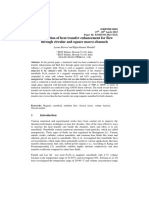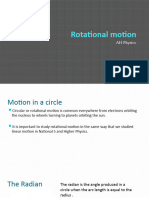Source: KDI Co .LTD, 2011
Source: KDI Co .LTD, 2011
Uploaded by
Siti NurshahiraCopyright:
Available Formats
Source: KDI Co .LTD, 2011
Source: KDI Co .LTD, 2011
Uploaded by
Siti NurshahiraOriginal Description:
Original Title
Copyright
Available Formats
Share this document
Did you find this document useful?
Is this content inappropriate?
Copyright:
Available Formats
Source: KDI Co .LTD, 2011
Source: KDI Co .LTD, 2011
Uploaded by
Siti NurshahiraCopyright:
Available Formats
INTRODUCTION FTIR is basically Fourier transform infrared spectroscopy .FTIR is one of the techniques in organic chemistry.
It is use to identify the presence of certain functional group in a molecules, to confirm the identity of a pure compound and to detect impurities in a substance by utilizing infrared absorption of molecules.Therefore, FTIR spectroscopy is a very powerful technique which provides fingerprint information on the chemical composition of the sample. Infrared spectroscopy is the study of interactions between matter and electromagnetic fields in the IR region. In this spectral region, the electromagnetic waves mainly couple with the molecular vibrations. In other words, a molecule can be excited to a higher vibrational state by absorbing IR radiation. The probability of a particular IR frequency being absorbed depends on the actual interaction between this frequency and the molecule. In general, a frequency will be strongly absorbed if its photon energy coincides with the vibrational energy levels of the molecule. Infrared light (IR) are electromagnetic radiation with have longer wavelength than those visible light. In the visible light region, lights color change from red to violet as their wavelength become shorter, and finally become invisible again. Then come the Ultraviolet (UV) lights whose wavelengths are longer than X-rays, ranging 10 nm to 400 nm. Rays ranging from 0.01 to 10 nanometers are classified into X-rays. Electromagnetic rays whose wavelength is shorter than X-rays are called Gamma rays.
Figure 1: Electromagnetic radiation
(Source: KDI Co .LTD, 2011)
THEORY There are three types of infrared spectroscopy which are infrared spectroscopy; dispersive infrared spectroscopy and Fourier transform infrared spectroscopy (FTIR). Absorption in infrared spectroscopy depends on the changes in vibrational and rotational of the molecules whereas in dispersive infrared spectroscopy, infrared light source is split into two beams. One beam passes through the sample compartment and another beam passes through reference cell. A monochromater is use to separate the source of infrared light (radiation source) into its different wavelength. In FTIR instrument, the manochromater and slits are replaced by interferometer, usually Michelson type. Generally in FTIR, all the source energy will send through the interferometer then pass through the beamspiltter. The beamspiltter will divide the beam radiation into two parts. One beam goes to a stationary mirror then back to the beamsplitter again. The other one goes to a moving mirror. The path difference between the two beams then allowed recombining. In this way, interference between the beams is obtained and the intensity of the output beam from the interferometer can be monitored as a function of path difference by using a detector.
Figure 2: Interferometer
(Source: K. Gable, 2013)
When the light passes through the interferometer, a cosine wave of constant frequency and intensity is obtained. The result is interferogram. This interferogram is generated by constructive and destructive interference of light as the distance between the two arms of the interferometer is varied. Let X is the distance between the beamsplitter and the stationary mirror
and Y is the distance of the beamsplitter and the moving mirror. Path difference between X and Y which is called retardation is Z. When X is equal to Y, the retardation, Z is zero then the beams are perfectly in phase. As a result, the beams interfere constructively at the beamspiltter and all the light from the source will reach the detector. The detector now report variation in energy versus time for all wavelength simultaneously. Energy versus time is an odd way to record a spectrum. A mathematical function called Fourier transform will allow us to convert intensity versus time spectrum to intensity vs. frequency spectrum.
Figure 3: Interferogram
SAMPLE OF ANALYSIS The normal instrumental process is as follows: 1. The Source: Infrared energy is emitted from a glowing from a source. 2. The Interferometer: The beam enters the interferometer where the spectral encoding takes place. The resulting interferogram signal then exits the interferometer. 3. The Sample: The beam enters the sample compartment where it is transmitted through or reflected off of the surface of the sample, depending on the type of analysis being accomplished. This is where specific frequencies of energy are absorbed. 4. The Detector: The beam finally passes to the detector for final measurement. The detectors used are specially designed to measure the special interferogram signal. 5. The Computer: The measured signal is digitized and sent to the computer where the Fourier transformation takes place. The final infrared spectrum is then presented to the user for interpretation and any further manipulation.
Figure 4: Sample analysis of FTIR
(Thermo Nicolet, 2001)
REFERENCE 1. K.Gable, 2013, FTIR Spectroscopy. Retrived from: http://.oregonstchemistryate.edu/courses/ch361 2. Lars and Claes, The Theory Behind FTIR Analysis. Retrieved from: http://turroserver.chem.columbia.edu/PDF_db/theory_ftir 3. Thermo Nicolet,2001,Introduction to Fourier Transform Spectroscopy Retrieved from: http://mmrc.caltech.edu/FTIR/FTIRintro.pdf 4. Department of Physics Faculty of Science National University of Singapore, Fourier Transform Infra-red (ftir) Spectroscopy . Retrieved from: http://www.physics.nus.edu.sg/~L3000/Level3manuals/FTIR.pdf
You might also like
- 2-14 Epoxidation of AlkenesDocument2 pages2-14 Epoxidation of AlkenesMohd Zulhelmi AzmiNo ratings yet
- Laser Flash Photolysis Purpose A Reactive Free Radical Ketyl IsDocument16 pagesLaser Flash Photolysis Purpose A Reactive Free Radical Ketyl IspathinfoNo ratings yet
- Visible and Ultraviolet SpectrosDocument55 pagesVisible and Ultraviolet SpectrosMarcos ShepardNo ratings yet
- (Jerry Workman JR.) The Handbook of Organic Compou (B-Ok - Xyz)Document1,489 pages(Jerry Workman JR.) The Handbook of Organic Compou (B-Ok - Xyz)Randy J Blanco100% (1)
- Shell and Tube Heat ExchangerDocument36 pagesShell and Tube Heat ExchangerSiti Nurshahira67% (3)
- FTIRDocument6 pagesFTIRAnubhav ShuklaNo ratings yet
- Tandem MS For Drug AnalysisDocument93 pagesTandem MS For Drug AnalysisrostaminasabNo ratings yet
- Atomic Emission Spectroscopy - University NotesDocument22 pagesAtomic Emission Spectroscopy - University NotesLilac44100% (1)
- Visible and Ultraviolet Spectroscopy-Part 2Document54 pagesVisible and Ultraviolet Spectroscopy-Part 2Amusa TikunganNo ratings yet
- Molecular Fluorescence SpectrosDocument9 pagesMolecular Fluorescence SpectrosInga Budadoy NaudadongNo ratings yet
- Clin. Chem. Assignment - SpectrophotometerDocument3 pagesClin. Chem. Assignment - SpectrophotometerMartin ClydeNo ratings yet
- Flame PhotometerDocument5 pagesFlame PhotometerسيليناNo ratings yet
- High Pressure Liquid Chromatography (HPLC) PDFDocument13 pagesHigh Pressure Liquid Chromatography (HPLC) PDFmitalNo ratings yet
- Instrumental Methods of Chemical Analysis: Infrared SpectrosDocument120 pagesInstrumental Methods of Chemical Analysis: Infrared SpectrosBhagyashree Pani100% (1)
- Conjugated Dyes Lab EditedDocument8 pagesConjugated Dyes Lab EditedGugu Rutherford100% (1)
- Various Tools and Techniques Used For Structural ElucidationDocument28 pagesVarious Tools and Techniques Used For Structural ElucidationAvinashNo ratings yet
- Flame Photometer 1Document21 pagesFlame Photometer 1Rabail Khowaja100% (2)
- UV-Vis Spectroscopy: Chm622-Advance Organic SpectrosDocument50 pagesUV-Vis Spectroscopy: Chm622-Advance Organic Spectrossharifah sakinah syed soffianNo ratings yet
- Flame PhotometerDocument18 pagesFlame PhotometerKuzhandai VeluNo ratings yet
- Porphyrins in Analytical ChemistryDocument16 pagesPorphyrins in Analytical ChemistryEsteban ArayaNo ratings yet
- Biochem Presentation 1 ...Document12 pagesBiochem Presentation 1 ...Rabia HussainNo ratings yet
- KK-CHP 3 (Aas)Document125 pagesKK-CHP 3 (Aas)ShafiqahFazyaziqah100% (1)
- Polymer Properties:Experiment 4 FtirDocument11 pagesPolymer Properties:Experiment 4 FtirfatinzalilaNo ratings yet
- C5 IR SpectrosDocument13 pagesC5 IR SpectrossuryaNo ratings yet
- Ion ChromatographyDocument2 pagesIon ChromatographyalexpharmNo ratings yet
- Atomic Absorption SpectrometryDocument36 pagesAtomic Absorption SpectrometryZubair Kamboh100% (1)
- Raman Spectroscopy For Quality Assessment of Meat and FishDocument13 pagesRaman Spectroscopy For Quality Assessment of Meat and FishYashaswini NagarajNo ratings yet
- IRDocument36 pagesIROctavio GilNo ratings yet
- Experiment 8Document8 pagesExperiment 8NathanianNo ratings yet
- Atomic Absorption SpectrophotometerDocument8 pagesAtomic Absorption Spectrophotometersaurabh_acmasNo ratings yet
- 1 - Basics of Molecular SpectrosDocument56 pages1 - Basics of Molecular SpectroscalfontibonNo ratings yet
- IR SpectrosDocument41 pagesIR SpectrosKD LoteyNo ratings yet
- Unit IV IR SpectroscoptyDocument37 pagesUnit IV IR SpectroscoptyNTGNo ratings yet
- Mass SpectrosDocument77 pagesMass SpectrosAbhay Partap Singh100% (1)
- Agilent 1200 PDFDocument24 pagesAgilent 1200 PDFChristine NataliaNo ratings yet
- Infrared SpectrosDocument24 pagesInfrared Spectrosdatha saiNo ratings yet
- Electrophoresis and Capillary Electrophoresis PDFDocument21 pagesElectrophoresis and Capillary Electrophoresis PDFVinay kumarNo ratings yet
- Field Desorption, Field IonisationDocument13 pagesField Desorption, Field Ionisationhey80milionNo ratings yet
- UNIT 14 Introductio To Analytical Instruments - Doc 12.5Document14 pagesUNIT 14 Introductio To Analytical Instruments - Doc 12.5NathanianNo ratings yet
- LCMS Introduction Part 1Document70 pagesLCMS Introduction Part 1rostaminasab100% (1)
- Atomic Absorption Spectrophotometry New PDFDocument69 pagesAtomic Absorption Spectrophotometry New PDFMonicia AttasihNo ratings yet
- Flame PhotometryDocument8 pagesFlame PhotometryNimra MalikNo ratings yet
- 1 - Introduction To Instrumental MethodsDocument19 pages1 - Introduction To Instrumental MethodsAtongo George AtiahNo ratings yet
- What Is Ion Chromatography?: A Division of Chemright Laboratories, IncDocument1 pageWhat Is Ion Chromatography?: A Division of Chemright Laboratories, IncSIU KMUNo ratings yet
- Mass SpectrosDocument47 pagesMass SpectrosEdward PittsNo ratings yet
- Lecture 1. Introduction To Various Analytical TechniquesDocument22 pagesLecture 1. Introduction To Various Analytical TechniquesMoiz Ahmed100% (1)
- Spectrophotometry Basic ConceptsDocument7 pagesSpectrophotometry Basic ConceptsVon AustriaNo ratings yet
- HPLC - New LatestDocument76 pagesHPLC - New LatestMuhammadAmdadulHoqueNo ratings yet
- Petroleum Analysis: Disusun Oleh: Rizza Umam AlharisDocument12 pagesPetroleum Analysis: Disusun Oleh: Rizza Umam Alhariskarwi DKNo ratings yet
- Voltammetry: A Look at Theory and Application: Bobby Diltz 14 March 2005Document15 pagesVoltammetry: A Look at Theory and Application: Bobby Diltz 14 March 2005tila100% (1)
- Absorbance and Fluorescence Spectroscopies of Green Fluorescent ProteinDocument24 pagesAbsorbance and Fluorescence Spectroscopies of Green Fluorescent ProteinMadel Tutor ChaturvediNo ratings yet
- Atomic Emission SpectrosDocument5 pagesAtomic Emission SpectrosBea Uy0% (1)
- Derivatives For HPLC AnalysisDocument68 pagesDerivatives For HPLC Analysismagicianchemist0% (1)
- Fourier-Transform Infrared Spectroscopy (FTIR)Document14 pagesFourier-Transform Infrared Spectroscopy (FTIR)Anushri VaidyaNo ratings yet
- Slab Planar: Charged Species Migration Rate Electric FieldDocument15 pagesSlab Planar: Charged Species Migration Rate Electric FieldEng Leng LeeNo ratings yet
- Lecture 1 - Basics in UV SpectrosDocument54 pagesLecture 1 - Basics in UV SpectrosEmmanuella OffiongNo ratings yet
- Columns for Gas Chromatography: Performance and SelectionFrom EverandColumns for Gas Chromatography: Performance and SelectionNo ratings yet
- Liquid Chromatography - Mass Spectrometry: An IntroductionFrom EverandLiquid Chromatography - Mass Spectrometry: An IntroductionNo ratings yet
- Batch Production of L-Phenylalanine and L-Aspartic AcidDocument2 pagesBatch Production of L-Phenylalanine and L-Aspartic AcidSiti NurshahiraNo ratings yet
- AdsorptionDocument56 pagesAdsorptionSiti Nurshahira100% (1)
- Dissolved Oxygen DO Titration X 10 MG/L Blank Sample Titration 079.DO Result 0.79 x10 7.9 MG/L ODocument2 pagesDissolved Oxygen DO Titration X 10 MG/L Blank Sample Titration 079.DO Result 0.79 x10 7.9 MG/L OSiti NurshahiraNo ratings yet
- Ion ExchangeDocument50 pagesIon ExchangeSiti Nurshahira100% (1)
- Chapter 2 - Lle EditedDocument60 pagesChapter 2 - Lle EditedSiti Nurshahira100% (1)
- Iscosity AND THE Mechanisms OF Momentum TransportDocument24 pagesIscosity AND THE Mechanisms OF Momentum TransportSiti Nurshahira100% (1)
- CHE 555 Roots of PolynomialsDocument12 pagesCHE 555 Roots of PolynomialsSiti NurshahiraNo ratings yet
- Chapter 3 - LeachingeditedDocument51 pagesChapter 3 - LeachingeditedSiti Nurshahira75% (4)
- T C M E T: Hermal Onductivity AND THE Echanisms OF Nergy RansportDocument15 pagesT C M E T: Hermal Onductivity AND THE Echanisms OF Nergy RansportSiti NurshahiraNo ratings yet
- Chapter 2 - Lle EditedDocument60 pagesChapter 2 - Lle EditedSiti Nurshahira100% (1)
- 2.0 Electric Circuits: - CPE 535 Electrical TechnologyDocument20 pages2.0 Electric Circuits: - CPE 535 Electrical TechnologySiti NurshahiraNo ratings yet
- Chapter 1 DistillationDocument110 pagesChapter 1 DistillationSiti Nurshahira80% (5)
- Chapter 1 DistillationDocument110 pagesChapter 1 DistillationSiti Nurshahira80% (5)
- Chapter 8 Turbulent Flow in Circular PipesDocument29 pagesChapter 8 Turbulent Flow in Circular PipesSiti Nurshahira100% (1)
- Class 11 Physics Unit 5 Motion of System of Particle and Rigid BodyDocument38 pagesClass 11 Physics Unit 5 Motion of System of Particle and Rigid Bodymatre.nishuNo ratings yet
- 1 - Gravitation (Theory) Short NotesDocument12 pages1 - Gravitation (Theory) Short NotesKartik P. SahNo ratings yet
- Q.1 Exam G.8Document15 pagesQ.1 Exam G.8Sameh MoftahNo ratings yet
- Electrical Heating-1Document13 pagesElectrical Heating-1Abdo EssaNo ratings yet
- 3.4 SoundDocument5 pages3.4 SoundAyana AkjolovaNo ratings yet
- Calibration of Flow Meters Lab Report PDFDocument10 pagesCalibration of Flow Meters Lab Report PDFsaasNo ratings yet
- GM CounterDocument3 pagesGM CounterJaya KumarNo ratings yet
- Antenna Designs With Electromagnetic Band Gap StructuresDocument71 pagesAntenna Designs With Electromagnetic Band Gap StructuresAnand Sreekantan ThampyNo ratings yet
- Physics (Work and Energy) Class IXDocument3 pagesPhysics (Work and Energy) Class IXAditya SinhaNo ratings yet
- HPH103 - Waves and Optics 1 - Lecture # 3Document22 pagesHPH103 - Waves and Optics 1 - Lecture # 3Praise Nehumambi100% (1)
- Symbols, Units and QuantitiesDocument2 pagesSymbols, Units and QuantitiesLayal AlyNo ratings yet
- First Page PDFDocument1 pageFirst Page PDFSAYAN CHAKRABORTYNo ratings yet
- Speed LogDocument23 pagesSpeed LogSwapnil Suhrid Joshi60% (5)
- ME 09 802 Compressible Fluid Flow APR 2013Document2 pagesME 09 802 Compressible Fluid Flow APR 2013sivanNo ratings yet
- A Brief and Transparent Derivation of The Lorentz-Einstein Transformations Via Thought ExperimentsDocument8 pagesA Brief and Transparent Derivation of The Lorentz-Einstein Transformations Via Thought ExperimentsMd Kaiser HamidNo ratings yet
- Heat Transfer T03-S04Document11 pagesHeat Transfer T03-S04craig walkerNo ratings yet
- Grade10 Q2 SLM1Document18 pagesGrade10 Q2 SLM1Archie Caba100% (1)
- Q3Document5 pagesQ3Kingking alcosebaNo ratings yet
- ChE by M.SubbuDocument198 pagesChE by M.SubbuUtkarsh TripathiNo ratings yet
- Null 5Document209 pagesNull 5Shuco TchiloNo ratings yet
- Investigation of Heat Transfer Enhancement For Flow Through Circular and Square Macro-Channels - Ayona BiswasDocument9 pagesInvestigation of Heat Transfer Enhancement For Flow Through Circular and Square Macro-Channels - Ayona Biswasvineet SinghNo ratings yet
- Acoustic Comfort Evaluation For A Conference Room A Case StudyDocument11 pagesAcoustic Comfort Evaluation For A Conference Room A Case StudyPieter Karunia DeoNo ratings yet
- Nirma University Institute of Technology Chemical Engineering DepartmentDocument1 pageNirma University Institute of Technology Chemical Engineering DepartmentAnurag SrivastavaNo ratings yet
- 11 Physics Sample Paper 1Document12 pages11 Physics Sample Paper 1KnvigneshwarNo ratings yet
- Final Report Falling StickDocument7 pagesFinal Report Falling StickDanish MoinNo ratings yet
- Physics Lab ManualDocument50 pagesPhysics Lab ManualNamani SanjayNo ratings yet
- AH RMA PPT 2.-Circular-MotionDocument16 pagesAH RMA PPT 2.-Circular-MotionFrank SkellyNo ratings yet
- Phase-Measurement Interferometry TechniquesDocument50 pagesPhase-Measurement Interferometry TechniquesAlex ZentenoNo ratings yet
- Part Two: Oscillations, Waves, & FluidsDocument32 pagesPart Two: Oscillations, Waves, & FluidssteveNo ratings yet
- Task 1 - Jennifer - TorresDocument11 pagesTask 1 - Jennifer - TorresjenniferNo ratings yet






































































































